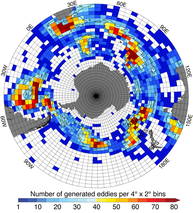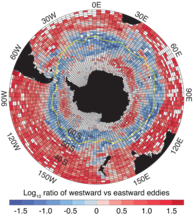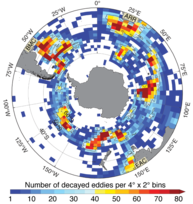Eddies' birth and decay around Antarctica
Image of the Month - May 2018

Part of the ocean heat, energy etc. are carried by eddies more than by the major current and their steady flow. Thus a better knowledge of eddies is important to understand the ocean dynamics.
In the Antarctic Circumpolar Current, specific regions can be delineated where eddies are born and where they mostly stay into. Those formation sites are downstream and on top of big topographic features, such as the Drake Passage, the Western Indian Ridge, the Kerguelen Plateau and Eastern Indian Ridge, the Campbell Plateau and Macquarie Ridge or the Eltanin Fracture Zone. Within the boundaries of the Antarctic Circumpolar Current eddies propagate Eastward. North and South of this current, eddies propagate Westward with a zonal drift in accordance with was found in other regions of the world ocean.
A 25 year long time series of eddy detection is now available and enable to better understand the general dynamics and average behavior of ocean features. With Jason-3, Sentinel-3A and the newly launched Sentinel-3B, the series is continuing even longer.
See also:
- Image of the Month, Sep. 2007: Altimetry on eddies' tracks
- Image of the Month, Mar. 2011: 177,000 eddies in the oceans
- Data: Global mesoscale eddy trajectory atlas products
Websites on this subject:
Reference
- Uriel Zajaczkovski, S. Gille and M. Mazloff: Eddy generation and decay in the Southern Ocean. J. Phys. Oceanogr. Under review






